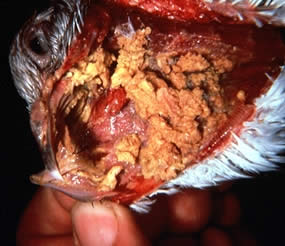
Jul . 29, 2024 11:51 Back to list
Trichomoniasis
Trichomoniasis
Trichomoniasis is a parasitic protozoan disease that affects domestic fowl, pigeons, doves, and hawks. It occurs in the digestive as either the ‘lower’ form, which is characterised by depression, weight loss and watery yellow diarrhoea or the ‘upper’ form, which is characterised by depression, drooling and repeated swallowing movements, sunken and empty crop, open-mouth breathing and bad odour. The upper form is rare in turkeys and chickens. Most caged, domestic and game birds (except waterfowl) are susceptible but the disease is more serious in young birds. Recovered birds remain carriers for life.

Exudate from Trichomoniasis in pigeon oral cavity Source: The Merck Veterinary Manual
Anti-trichomonad in bird
What causes trichomoniasis?
Trichomoniasis is caused by infection with the parasitic protozoa Trichomonas gallinae. This protozoan has variable pathogenicity (ability to cause disease). Transmission of the protozoa is by bird to bird contact or by contact with infected litter, feed or water. The protozoa are shed in the faeces of infected birds and can be regurgitated in crop milk.
Treatment and prevention of Trichomoniasis
Treatments are available that will control the disease but there may be restrictions on their use in commercial flocks. Prevention requires good biosecurity and management practices to eliminate the sources of infection. Drain water pools on ranges, screen out wild birds, separate young birds from adults as well as susceptible birds from recovered (carrier) birds.
-
Premium Young Chicken - Leading Young Chicken Manufacturer & Supplier for Fresh Poultry Needs
NewsJul.08,2025
-
Enterococcus Faecalis Mold Remover – Powerful & Safe Solution from Trusted Manufacturer
NewsJul.08,2025
-
Premium Diarrhea Treatment Solutions Leading Diarrhea Factories & Suppliers
NewsJul.08,2025
-
High-Quality Blisters Manufacturer & Supplier Reliable Blisters Factory
NewsJul.07,2025
-
High-Quality Skeleton Development Services Leading Factory, Manufacturer & Supplier
NewsJul.07,2025
-
High-Quality Cockscomb Turns White Reliable Manufacturer & Supplier Factory
NewsJul.07,2025





